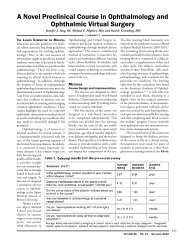Hyperuricemia & Gout - Rhode Island Medical Society
Hyperuricemia & Gout - Rhode Island Medical Society
Hyperuricemia & Gout - Rhode Island Medical Society
Create successful ePaper yourself
Turn your PDF publications into a flip-book with our unique Google optimized e-Paper software.
Treatment Failure <strong>Gout</strong><br />
Saman Ali, MD, and Edward V. Lally, MD<br />
<br />
Treatment options for gout are well<br />
established and reasonably effective. 1<br />
They include anti-inflammatory agents<br />
such as non-steroidal anti-inflammatory<br />
drugs (NSAIDS), glucocorticoids and<br />
colchicine and urate-lowering therapies<br />
such as allopurinol and probenecid.<br />
However, despite the availability of effective<br />
urate-lowering therapy, there remains<br />
a subset of patients with gout who, despite<br />
aggressive therapy, have intractable<br />
disease, manifest as recurrent gout flares,<br />
chronic arthritis and progressive tophaceous<br />
deposits. These patients are referred<br />
to as having “refractory gout” or “treatment<br />
failure gout” (TFG). 1 The term<br />
“treatment failure gout” includes five ways<br />
by which patients may develop poorly<br />
controlled disease. These pertain mainly<br />
to the use of urate-lowering therapy and<br />
include delayed prescribing, inadequate<br />
dosage, intolerance, noncompliance and<br />
inadequate response in spite of generally<br />
acceptable dosages. 2 (Table 1) The new<br />
xanthine oxidase inhibitor febuxostat<br />
(Uloric) has not been studied in TFG,<br />
but may ultimately prove useful for this<br />
indication. Febuxostat is discussed elsewhere<br />
in this journal.<br />
Regardless of the pathway, all patients<br />
with treatment failure gout are<br />
unable to reduce and maintain serum<br />
urate below the therapeutic target of 6<br />
mg/dl. 2 An estimated 100,000 to<br />
300,000 of the nearly 3 million cases of<br />
gout in the US are not adequately managed<br />
with current therapies. 3 Additionally,<br />
many patients with gout have significant<br />
and multiple co-morbidities that<br />
preclude the use of those therapies.<br />
Allopurinol, the most common treatment<br />
used to lower serum urate levels, is<br />
generally regarded as safe and effective. 3<br />
It lowers serum urate by inhibiting the<br />
purine nucleotide pathway enzyme xanthine<br />
oxidase. However, about 20% of<br />
patients receiving allopurinol report side<br />
effects and about 5% discontinue the<br />
medication due to intolerance. 4 Allopurinol<br />
may also be contraindicated because<br />
of potential adverse drug interaction<br />
with azathioprine. 5 Moreover, the presence<br />
of kidney disease may preclude adequate<br />
dosing because allopurinol-related<br />
toxicity is increased in the presence of significant<br />
renal impairment. Even though<br />
severe toxicity is rare, inadequate dosing<br />
of allopurinol to achieve target serum<br />
urate level
















